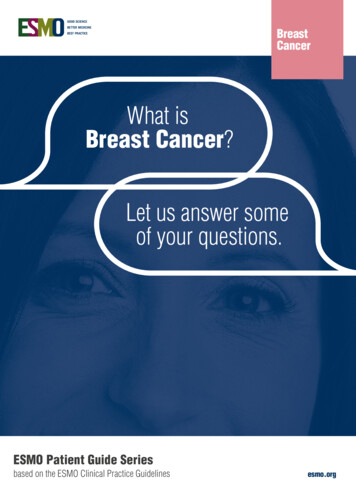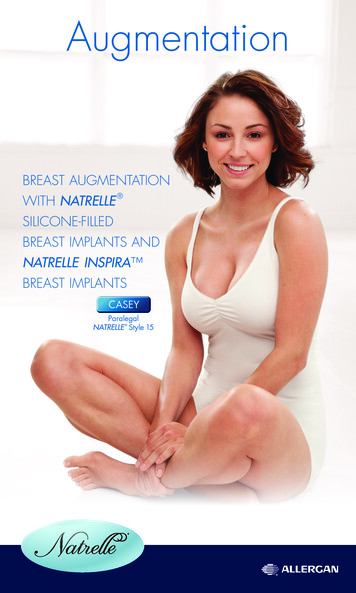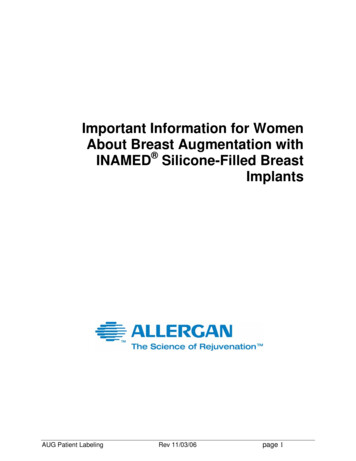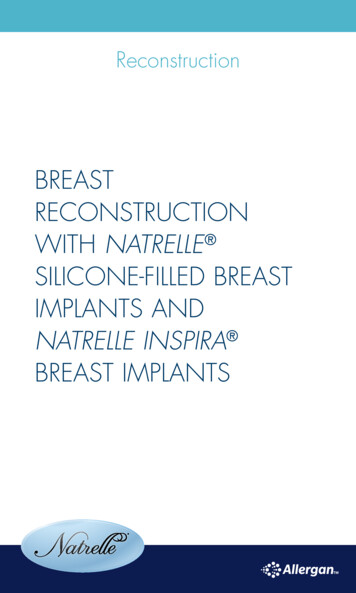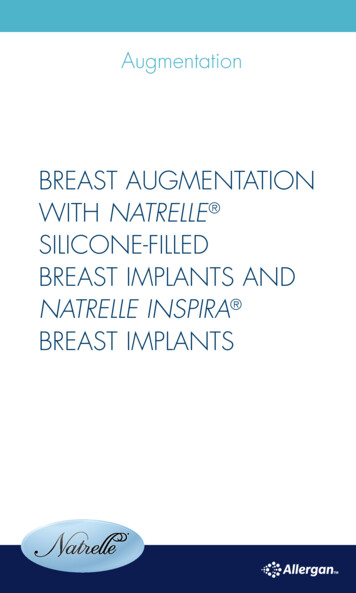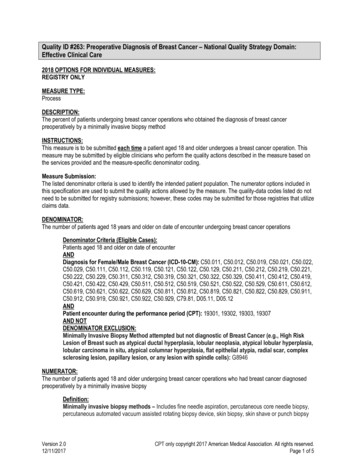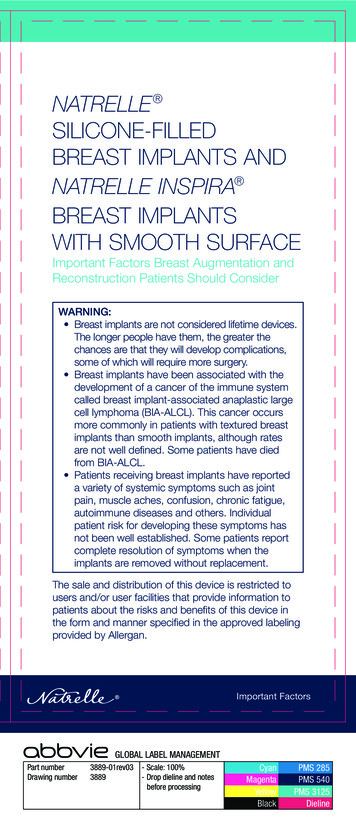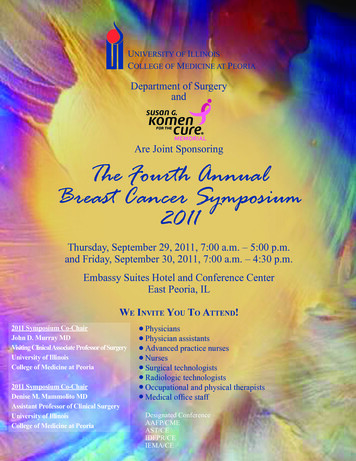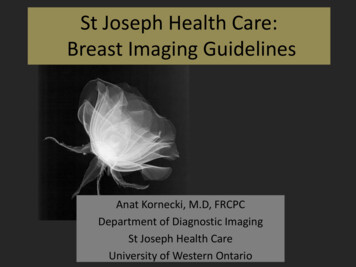
Transcription
St Joseph Health Care:Breast Imaging GuidelinesAnat Kornecki, M.D, FRCPCDepartment of Diagnostic ImagingSt Joseph Health CareUniversity of Western Ontario
Breast Imaging: Clinical Settings Screening Diagnostic
Screening For Breast CancerThe use of diagnostic imaging in early detectionof breast cancer in an asymptomatic patient. Mammography Ultrasound MRI
Mammography Mammography should always obtain as it isthe only proven screening tool
Standard Mammography Views Two-view mammography (mediolateraloblique and craniocaudal projections of eachbreast) is required at each attendance Additional view may be required depends onbody habitus
Screening Mammography Women over the age of 50 with no history ofbreast cancer or implants: OBSP Over 25% life time risk 30-69 (including personalhistory of cancer or implants) : OBSP Women at the age of 30-50 : Clinician referral Personal history of breast cancer: Clinicianreferral Patients with Implants: Clinician referral Over 25% life time risk 25-30: Clinician referral
Screening Mammography Screening mammography is not offered to: Patients younger than 30 Pregnant Lactating Male
Screening Ultrasound Over 25% life time risk 30-69 who cannottolerate an MRI: OBSP Disabled patients who cannot have standardmammographic views Screening ultrasound is not offered to patientswho cannot tolerate a mammogram for anyother reason
Screening MRI Over 25% life time risk 30-69 : OBSP For those who are not approved by the HighRisk OBSP: requisitions should be signed by asurgeon, oncologist or radiation oncologist
Non- OBSP Screening MRI Patients under 70 BRCA carriers under 30: Starts 10 years prior to age ofthe youngest family member being diagnosed Patients under 30, 8 years or more after exposure tochest wall radiation Previous breast cancer and over 50% breast density Biopsy proven ALH/LCIS and over 50% breast density Inherited disease associated with high risk (Li Fraumenisyndrome, Cowden’s disease etc.) Previous mastectomy (uni or bilateral) withpositive/tight margins
Diagnostic Breast ImagingThe use of diagnostic imaging in theassessment of breast symptoms or breastabnormalities suspected on previous studies. Mammography Ultrasound MRI
Diagnostic Mammography: Work-UpOffered for an abnormality detected on routinemammographic views: Additional mammographic views Two view finding: Cone magnification/conecompression views, lateral view and anyadditional views that may be helpful to locatethe lesion
Diagnostic Mammogram: Calcifications Magnification views Defined as benign, indeterminate orsuspicious
Diagnostic Mammogram: Calcifications Benign calcifications : no further assessment Indeterminate/ suspicious: stereotactic guidedbiopsy Several indeterminate clusters: biopsy of themost suspicious one. The additional cluster/swill be biopsied if results are malignant Several suspicious clusters: biopsy of morethan one cluster, taking in consideration theimpact on surgery
Diagnostic Mammogram: Calcifications At SJHC we tend to biopsy most calcificationsunless typically benign May follow-up multiple clusters if only one isbiopsied The radiologist may offer to follow-upcalcifications if not all calcifications in a clusterappear to layer
Mammogram: Mass Additional cone compression/magnificationviews to assess borders and associatedcalcifications US If mass cannot be identified on US:stereotactic biopsy or MRI
Diagnostic Mammogram: Asymmetry/focal asymmetry/ distortion Additional mammographic views US if abnormality persist or if remainindeterminate, especially if dense breast If there is persistent abnormality and US isnegative, the radiologist may offer short termfollow-up mammogram, stereotactic biopsyor MRI depends on level of concern
Diagnostic Ultrasound Breast symptoms Initial imaging evaluation breast symptoms inpatient under 30 years and in lactating andpregnant women Evaluation of abnormalities detected on otherimaging studies Evaluation of the axilla Guidance of breast interventional procedures
Diagnostic Ultrasound: Cysts Simple cysts: Benign, no follow-up. Aspirationif requested by patient Complicated cysts( internal debris,inflammatory changes, thin septations ):Follow-up, unless multiple similar findings.The radiologist may offer follow-up for aspecific complicated cyst if there is uncertainty Complex cysts: (thick septations, intra muralnodule, internal flow): Biopsy
Solid Masses If benign features ( slightly hypoechoic, ovalshaped, parallel to the skin, encapsulated andup to 4 macrolobulations): Follow-up If even one malignant feature ( spiculations,microlobulation, distortion, shadowing etc.):Biopsy If indeterminate finding: Biopsy
Diagnostic MRI May change the planned treatment Interpretation must correlated to mammogram andultrasound findings Should not supplant careful problem-solvingmammographic views or ultrasound and should notbe used in lieu of biopsy of a suspicious finding MRI-guided intervention should be available
Diagnostic MRI Exclusion of multifocal/ multi-centric/bilateral disease Assessment of extensiveness of malignancy in patientswith dense breast or patients with implants Mammographically occult malignancy Confirmation of locally advanced cancer Respond to neoadjuvant chemotherapy Recurrent disease/residual disease Metastatic axillary nodes of unknown origin Persistent bloody or clear nipple discharge Prior to prophylactic mastectomy
Diagnostic Mammography: PalpableLump Symptomatic patients with no mammogram inthe last year: Standard views with BB marker Symptomatic patients with previousmammogram less than a year, more than 6months: ipsilateral standard mammographicviews with BB marker
Palpable lump Mammogram is not offered for: Symptomatic patients who had mammogramin the last 6 months Female patients under 30, pregnant orlactating patient and male patients under 20 Patient who refuses a mammogram shouldsign a consent form Targeted US is always offered
Palpable Lump If a malignancy is identified than the entireipsilateral breast and axilla are scanned andmammogram is obtained regardless of age orcondition Negative mammogram and ultrasound in thesetting of palpable lump does not excludemalignancy and clinical follow-up is required.MRI can be obtain if persistent palpable lumpsuspected by surgeon
Breast Pain Mammogram only. US is not offered unlesssymptoms persist If the patient is younger than 30, pregnant orlactating: Targeted ultrasound
Spontaneous Nipple Discharge Six months trial: patient seen first by asurgeon. Mammogram for patient older than 30 andany other imaging requested by the surgeon
Spontaneous Nipple Discharge Mammogram and ultrasound. The radiologistexamine the breast. Galactography will berecommended If doable, even if an abnormality isdetected by US, for the exclusion of multiplefilling defects US guided biopsy for indeterminate lesions butonly after a galactography MRI is recommended for persistent bloody nippledischarge if other imaging studies are negative
Patients with Implants Significant technical and interpretationaldifficulties Routine plus displacement techniques describedby Eklund The risk of prosthesis rupture as a result ofcompression during mammography is extremelysmall In case that there is concern for rapturemammography is not performed in case theexamination is blamed for producing an existingabnormality
Silicon Implants Rapture If there is concern for silicon implant rupturean MRI will be obtained with implant protocol(i.e. without i.v contrast) Occasionally, the radiologist may recommendthe use of contrast, especially if the patient isdid not have mammogram for many years MRI is not offered for future screening
Diagnostic Mammogram:Lymphadenopathy If associated with primary breast malignancy, USguided biopsy of clinically suspicious nodes ONLY( i.e, when there is concern for macroscopicinvolvement) MRI if metastatic adenocarcinoma and no breastorigin is found on mammogram and/or US US of the contralateral axilla if no breast originfound, to exclude lymphoma Biopsy and flow cytometry when there is concernfor lymphoma
When Do We Have to Recommend Biopsy? Indeterminate or suspicious breast imaging lesionsNew solid palpable over 30yNew solid mass not seen on previous mammogramGrowing solid or complicated cystic massWhen there is even one concerning featureWhen not all benign features are presentFor a complex cystic lesion
Imaging Guided Breast Biopsy The best results achieved under imagingguidance with 14-gauge needle mounted on aspring-loaded biopsy device Vacuum-assisted biopsy will yield greaterdiagnostic accuracy however it is expensive The imaging assessment and thehistopathologic interpretations should becorrelated for concordance by the physicianperforming the biopsy
Imaging Guided Breast Biopsy One year follow-up mammogram isrecommended for negative, concordant biopsyresults The radiologist may recommend short-termfollow up for indeterminate findings Surgical excision is recommended for anysuspicious mass regardless the pathology results Hormone receptors assessment is requestedwhen neoadjuvant treatment is contemplated bythe radiologist
Tissue Marker Tissue marker is inserted whenever there is a risk thatthe abnormality will not be visualised after the Tissue marker is inserted prior to neoadjuvantchemotherapy, if lumpectomy is contemplated Tissue marker is always left after MRI guided biopsy Standard and true lateral mammographic views areobtain if a tissue marker is inserted Tissue marker migration should be treated with cautionif will be used for pre operative localization
Pre-Operative Imaging Localization US-guided localization when the lesion is identifiable Mammographic guidance for microcalcifications or lesionsseen only on mammography or lesion marked with tissuemarker and is not seen on US Bracketing technique for large area is recommended The tissue marker inserted following using MRI guidancecan be localized under mammography. Wider excision isrequired as there is an expected larger clip mobility giventhe use of vacuum-assisted device Specimen radiography is required to confirm adequatesampling If there is doubt regarding adequate surgical excision,repeat imaging is required to be obtained in a month toensure that the lesion had completely excised
MRI Guided Localization If there is concern for significant clip migration For lesion seen on MRI only and not amenablefor biopsy by being located too deep
Pre-Operative Imaging Localization Following the imaging guidance localizationstandard and true lateral mammographicviews are obtain The radiologist provides the surgeon therequired landmarks: lesion location, size ofwire inside the breast and location of the wirein relation to the lesion
Deep Lesions A wire may be inserted anterior to the lesion andnot through the lesion Skin marking may be the only option for deeplesions, using mammogram, ultrasound or MRIguidance The radiologist provides as many as possiblelandmarks to direct the surgeon Specimen radiography is required Repeat Imaging will be required in a month toensure that the lesion had completely excised
Suspicious One View Finding If a lesion is not amenable for biopsy surgical excision isrequired Attempt should be made to appreciate the location ofthe lesion with any other imaging modalities Deep axillary tail lesions and medial lesions which arelocated very high are difficult to be seen on two views The findings should be carefully reviewed with thesurgeon. Surgery may be required to be obtain inseveral steps with interval specimen radiography Repeat mammography will be required in a month toensure that the lesion had completely excised
Pre-Operative Galactography Galactography can be used to localize lesion priorto surgery by injecting blue dye mixed with iodinebased contrast into the discharging orifice Wire can be inserted into the filling defect iflocated far from the nipple Standard and lateral mammographic views areobtain after the procedure The radiologist provides the surgeons specificlandmarks of the location of the lesion usingo’clock face and distance from the nipple
The breast Imaging Report The ACR BI-RADS lexicon provides a framework forreporting using specific descriptors. The report shouldestablish levels of suspicion and providerecommendations The location of breast abnormality can be indicated byusing clock face, quadrant, depth and distance fromthe nipple Recommendations for subsequent follow-up studiesshould be included in the report. Overall finalassessment of findings is based on all imaging studiesperformed that day and common report may be issued The conclusion must follow the categories defined inthe ACR BI-RADS lexicon
The breast Imaging Report BI-RADS 0: Incomplete assessment: Need additional imagingevaluation and/or prior mammograms for comparison BI-RADS 1: Negative for breast malignancy BI-RADS 2: Benign finding(s) BI-RADS 3: Probably benign finding –short-interval follow-upBI-RADS 4: 2- 95% chances of malignancy – biopsy should beconsidered BI-RADS 5: Highly suggestive of malignancy – appropriateaction should be taken BI-RADS 6: Biopsy – proven malignancy –appropriate actionshould be taken
The breast Imaging Report Screening mammography can be only concluded as BIRADS1, 2 or 0 BI-RADS Category 0 assessments are assigned to incompleteevaluations. Additional mammography views, ultrasound, orprevious studies are necessary A category 3, 4, or 5 assessment is not recommended for ascreening mammogram, although in some instances a highlysuspicious abnormality may be identified that will warrant arecommendation for biopsy
The breast Imaging ReportBI-RADS 3 follow-up: Usually offered for a period of 2 years at 6months, 12 months and 24 months using themodality where the abnormality is seen the best Mammogram should always obtain every yearunless the patient is younger than 30, pregnantor breast feeding The report during the period of follow-up shouldalways included information regarding the nextsuggested appointment by mentioning themonth, year and the modality (ies) to use
The breast Imaging ReportBI-RADS category 4 or 5 An attempt to perform the biopsy same day or toarrange an urgent appointment and to deliver thepatient with the information regarding the timeand the date should be obtained if possible The communication is documented in themammogram report. If the date and time of theappointment is known, this should be mentionedin the report
University of Western Ontario . Breast Imaging: Clinical Settings Screening Diagnostic . . Ultrasound MRI . Mammography Mammography should always obtain as it is the only proven screening tool . Standard Mammography Views Two-view mammography (mediolateral oblique and craniocaudal projections of each breast) is required at .
